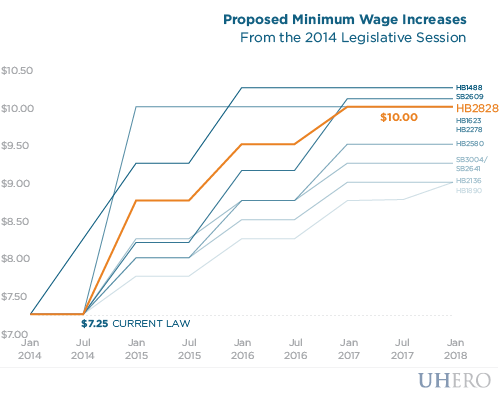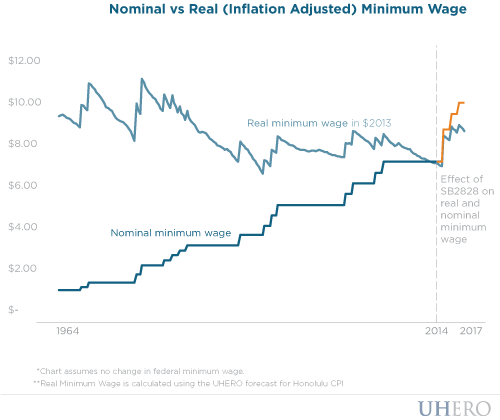By Carl Bonham
Ten different bills have been introduced at the legislature this session to raise Hawaii’s minimum wage. According to proponents, raising Hawaii’s minimum wage is necessary to help the working poor whose buying power has diminished. In the past, UHERO briefs and blog posts have argued that the minimum wage is not an efficient tool to fight poverty and pointed to the earned income tax credit as a more effective tool. On the flip side, we have pointed out that, unlike other anti-poverty programs, raising the minimum wage is politically attractive because it involves almost zero administrative cost and no new government expenditures. This post focuses on the growing body of economic evidence that small minimum wage increases reduce poverty and have little or no adverse effects on employment levels.

For example, a new paper by Arindrajit Dube from the University of Massachusetts Amherst finds that raising the minimum wage by 10 percent (for example from $7.25 to $8.00) would reduce the number of people living in poverty by 2.4%. Dube’s paper makes use of data from the Current Population survey for the period between 1990 and 2012 to examine the impact of minimum wages on the distribution of family incomes for non-elderly individuals. This line of research generally compares areas with minimum wage changes to a control group of areas with no minimum wage changes. A key contribution of Dube’s work is demonstrating that estimates from earlier research suffer from serious limitations due to their failure to adequately control for state-level economic performance unrelated to minimum wage hanges. When he accounts for these factors, he finds larger anti-poverty effects and “robust evidence that higher minimum wages moderately reduce the share of individuals with incomes below 50, 75 and 100 percent of the federal poverty line.” To put these findings in perspective, SB 2828 introduced on behalf of Governor Abercrombie would increase the Hawaii’s minimum wage to $8.75 dollars/hour in 2015 and could help reduce Hawaii’s population living below the poverty line by more than 7,000 persons. The additional increases to $10/hr in 2010 may reduce poverty even further, but note that the estimated 2.4% reduction in poverty is based on the small minimum wage changes observed historically and such estimates should generally not be extrapolated to reach conclusions about much larger changes.

While the conclusion that an increase in the minimum wage helps to reduce poverty is fairly widely accepted (even if there are more efficient but less politically acceptable means of attacking poverty), many economists will still point to the potential negative effects of raising the minimum wage on employment levels. Any Econ 101 student should know that imposing or raising a minimum wage in a competitive labor market reduces the quantity of labor demanded and leads to unemployment. But this theoretical prediction is subject to empirical verification, and this is where much of the economic debate has occurred during the past 20 years. A recent paper by Dube, Lester, and Reich (2010) compares changes in restaurant employment across contiguous U.S. counties with different minimum wage levels using quarterly data from 1990 to 2006. Their rich data set provides them with significantly more experimental variation than most of the literature, and they find “strong earnings effects and no employment effects of minimum wage increases.” Using the same statistical techniques common in the earlier literature, they largely replicate the literature’s finding of job losses associated with minimum wage increases. But when they control for regional and local differences in employment trends that are unrelated to the minimum wage, they find “no detectable employment losses from the kind of minimum wage increases we have seen in the United States.”
There is no doubt that the debate over the impact of minimum wage laws is alive and well. But there is some evidence that economists are leaning towards raising the minimum wage and indexing it to inflation. In a survey of 41 leading economists by the the University of Chicago’s Booth School of Business, 47% agreed that the benefits outweigh the costs of such a policy, while only 11% disagreed (the rest of the panel had no opinion or were unsure). Research is increasingly turning to the question of how can a minimum wage increase not lead to job losses. While the Econ 101 competitive model of labor markets leads to the invariable conclusions that there will be job losses, there are a wide variety of frictions and costs that are not considered in this simple model. For example the costs of job search may result in lower turnover when minimum wages are higher. It is possible that some employers will be discouraged from creating new jobs as minimum wages rise, but others will be more successful in filling positions and retaining workers. As you might have guessed, Dube, Lester and Riech (2013) find evidence that worker turnover falls sharply following a minimum wage increase while overall employment in low-wage sectors is largely unchanged. A survey of the literature conducted by John Schmitt at the Center for Economic and Policy Research summarizes the research into why minimum wage increases don’t lead to employment losses. The evidence suggests that businesses adjust to minimum wage changes in a wide variety of ways, and that reductions in labor turnover; improvements in organizational efficiency; reductions in wages of higher earners (“wage compression”); and small price increases “appear to be more than sufficient to avoid employment losses, even for employers with a large share of low-wage workers.”
BLOG POSTS ARE PRELIMINARY MATERIALS CIRCULATED TO STIMULATE DISCUSSION AND CRITICAL COMMENT. THE VIEWS EXPRESSED ARE THOSE OF THE INDIVIDUAL AUTHORS. WHILE BLOG POSTS BENEFIT FROM ACTIVE UHERO DISCUSSION, THEY HAVE NOT UNDERGONE FORMAL ACADEMIC PEER REVIEW.